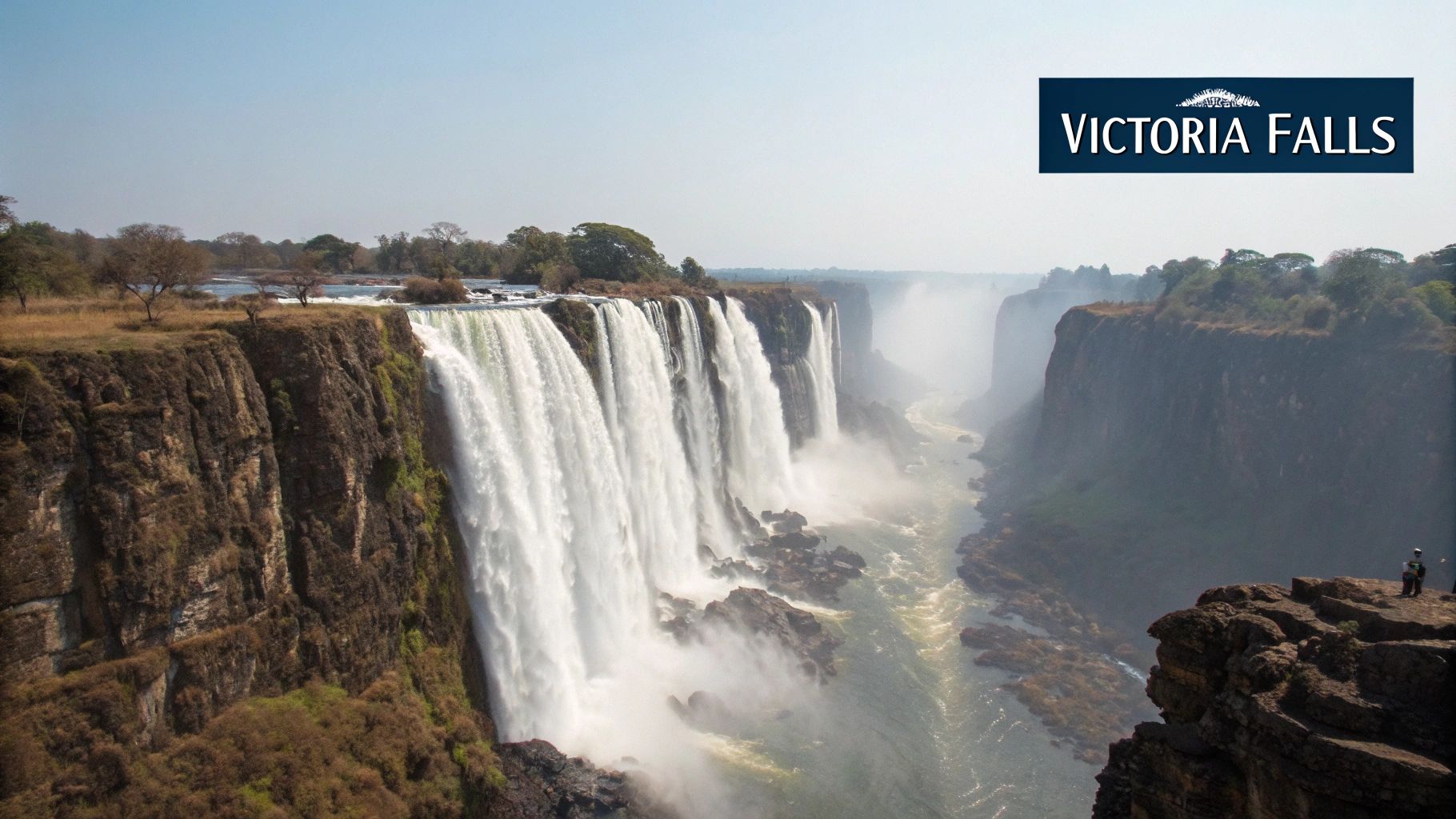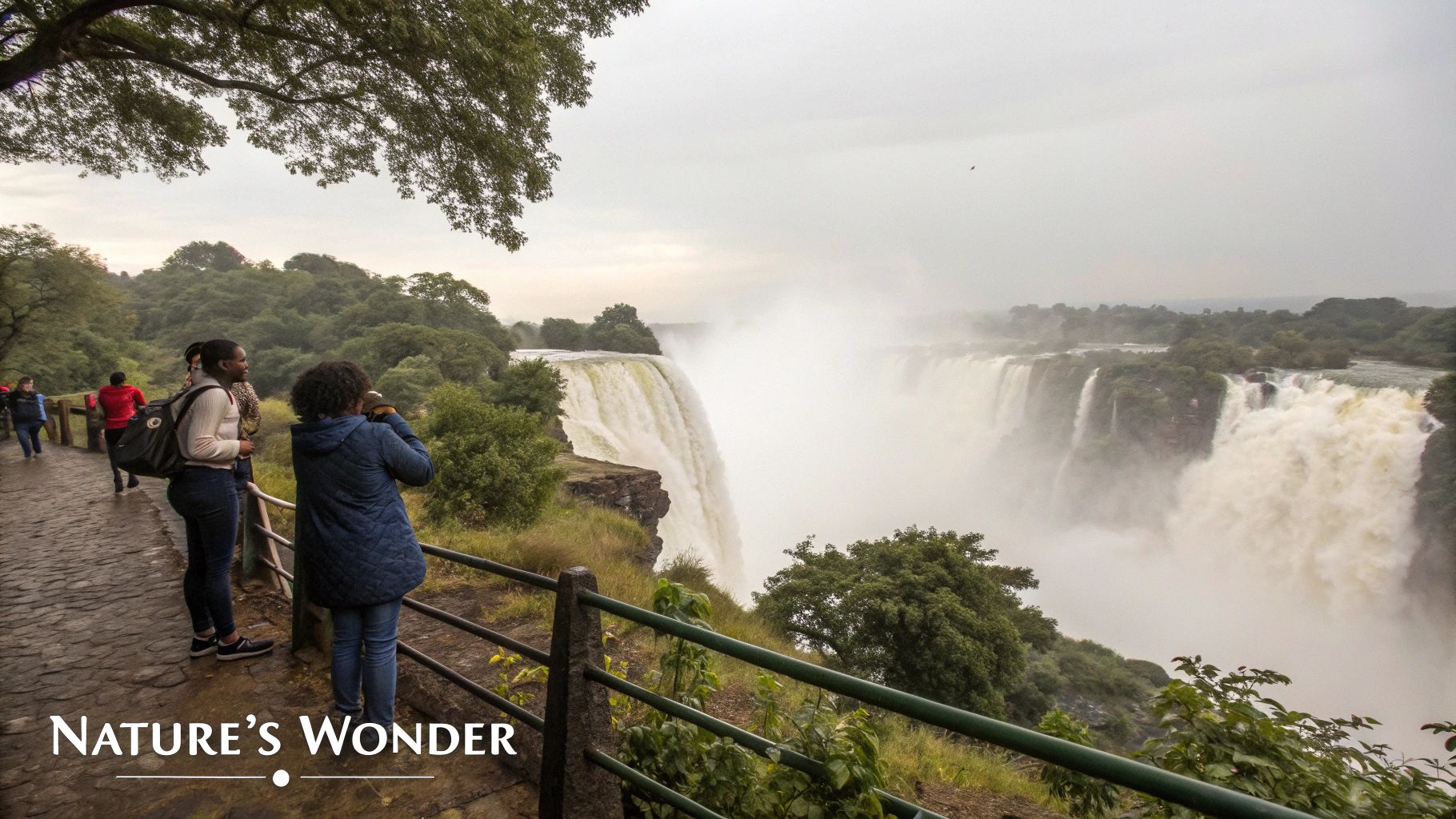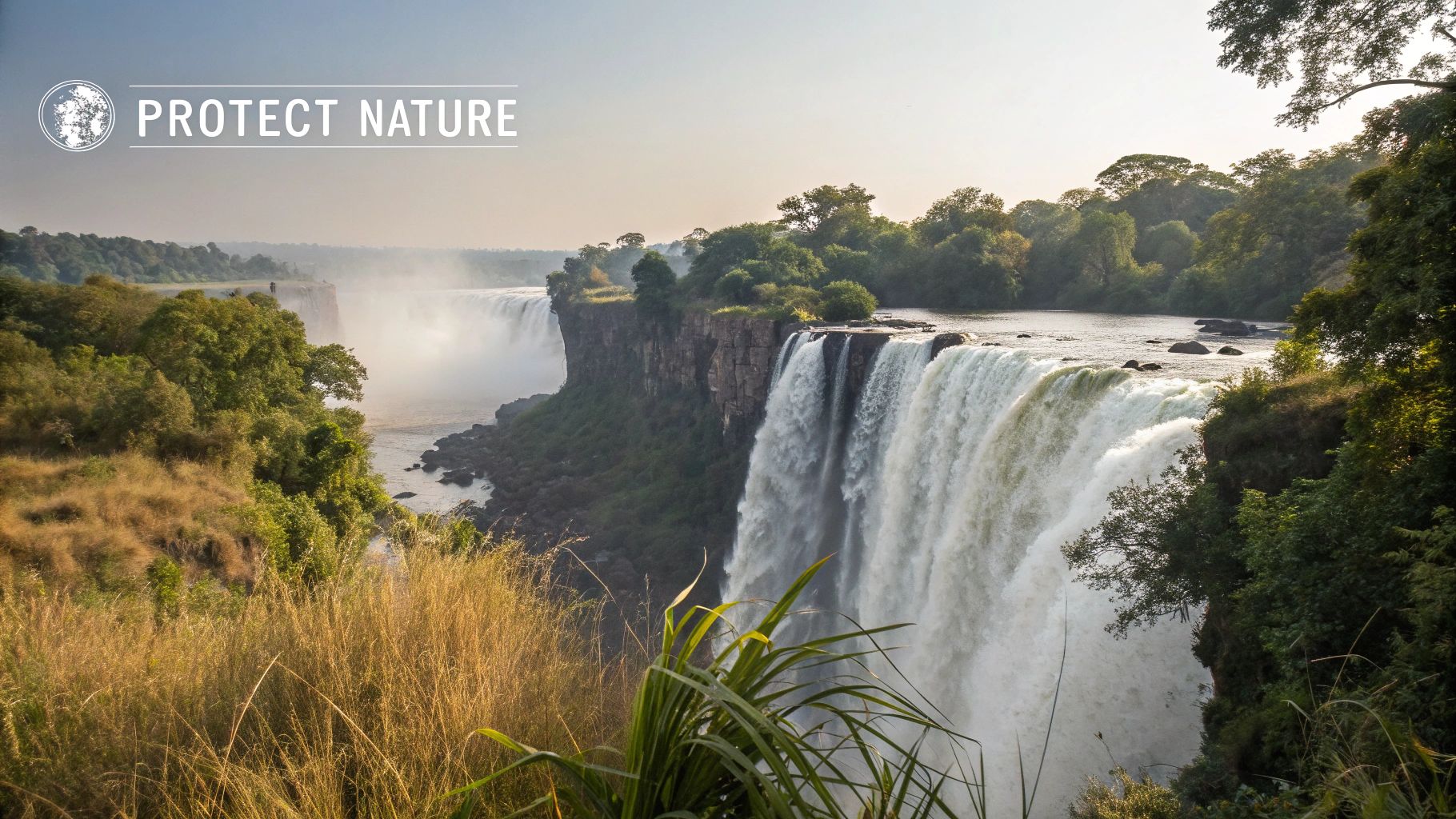Where is Victoria Falls? Explore Africa's Iconic Wonder
Table of contents [Show]
- Pinpointing Victoria Falls: Africa's Geographical Marvel
- Reaching Victoria Falls: Essential Travel Strategies
- Victoria Falls Access Points Comparison
- The Dramatic Discovery of Where Is Victoria Falls
- Zimbabwe vs. Zambia: Which Side Offers the Best Experience?
- The Remarkable Ecosystems Where Victoria Falls Thrives
- Victoria Falls' Powerful Impact on Regional Economies
Pinpointing Victoria Falls: Africa's Geographical Marvel
Victoria Falls, a breathtaking natural wonder, is renowned as one of the largest waterfalls on Earth. But where exactly can you find this iconic landmark? It sits in southern Africa, forming a dramatic natural boundary between Zambia and Zimbabwe. This unique location offers visitors incredible views and diverse experiences depending on which side they choose to explore.
The magnificent waterfall is located approximately halfway along the Zambezi River’s 2,700 km course, from its source to the Indian Ocean. This central position influences the falls' characteristics throughout the year. The water volume cascading over the falls varies dramatically between the wet and dry seasons, affecting both visibility and the overall experience. You might be interested in: our location guide.

Understanding the Geographic Impact
The falls' location has significantly shaped the landscape and human activity in the region. The Zambezi River and Victoria Falls have historically influenced settlement patterns, establishing natural paths for trade and travel. This has contributed to the falls' accessibility, making it a relatively easy destination to reach within the vast African continent.
Victoria Falls sits on the border of Zambia and Zimbabwe in southern Africa. This incredible waterfall is situated on the Zambezi River, about halfway along its 2,700 km journey to the Indian Ocean. Locals call it 'Mosi-oa-Tunya,' meaning 'the smoke that thunders,' because of the immense spray and roaring sound. Discover more insights about Victoria Falls. This evocative name captures the awe-inspiring experience of witnessing this natural wonder.
Victoria Falls’ division between two countries offers a unique benefit for travelers. Both Zambia and Zimbabwe provide distinct views, allowing visitors to appreciate its beauty from different angles. The Zimbabwean side offers a wider panoramic vista, often described as encompassing roughly 75% of the falls. The Zambian side offers a closer, more intimate experience, especially during the dry months. These varying vantage points give a richer, more complete understanding of Victoria Falls’ grandeur and scale.
Reaching Victoria Falls: Essential Travel Strategies
Planning a trip to Victoria Falls is an exciting endeavor. It requires more than just booking flights and accommodation. A strategic approach to your travel logistics will ensure a smooth, enriching experience from the moment you touch down. This starts with choosing the right arrival airport and understanding your ground transportation options.
Choosing Your Arrival Airport
Two primary airports serve as gateways to this magnificent natural wonder: Victoria Falls Airport (VFA) in Zimbabwe and Livingstone Airport (LVI) in Zambia. Your best choice will depend on a few factors, including your itinerary, budget, and visa requirements.
Victoria Falls Airport (VFA): Located closer to the falls, VFA offers the advantage of quicker and often cheaper transfers. This is a convenient option for those eager to experience the falls without delay.
Livingstone Airport (LVI): Situated a bit further from the falls, LVI offers a wider selection of accommodations. This makes it a good option for those who want to explore Zambia in more depth.
Victoria Falls' unique location on the border of Zimbabwe and Zambia adds an interesting element to travel planning. Crossing between the two countries is generally straightforward, thanks to the Univisa available at both airports. The Univisa simplifies travel between Zimbabwe and Zambia. However, always check the latest visa regulations before you travel, as these can be subject to change.
Transportation From Airports to the Falls
After arriving, you'll have several ground transportation options to choose from:
Taxis and Private Transfers: These offer the most convenient door-to-door service.
Airport Shuttles: A budget-friendly option, often shared with other travelers.
Rental Cars: Renting a car allows for more independent exploration, though driving conditions can vary, so self-drive isn't always recommended.
To help you compare the access points, we've created a comparison table outlining the pros and cons of each:
Victoria Falls Access Points Comparison
| Access Point | Country | Nearest Airport | Distance to Falls | Best For |
|---|---|---|---|---|
| Victoria Falls Town | Zimbabwe | VFA | Closer | Quick access to the falls |
| Livingstone Town | Zambia | LVI | Further | Wider accommodation choices, exploring Zambia |
As you can see, choosing the right access point can significantly impact your overall experience.
Getting Around Once You're There
Efficiently navigating between viewpoints and activities is key to maximizing your time at Victoria Falls. Walking is a great option for exploring the immediate area around the falls. Taxis and local buses can take you to more distant locations. For an unforgettable experience, consider a helicopter tour for spectacular aerial views. During peak season, booking transportation and tours in advance is highly recommended. Read also: our tour guide for helpful tips.
Careful planning will ensure your Victoria Falls trip is seamless and memorable. By strategically considering your travel arrangements, you can spend less time on logistics and more time immersed in the wonder of this breathtaking natural marvel.
The Dramatic Discovery of Where Is Victoria Falls
The cascading waters of Victoria Falls have captivated people for centuries. However, the narrative surrounding their “discovery” is a nuanced one. While local communities have always known and revered the falls, their introduction to the Western world is often linked to a specific historical event. This event propelled the falls from a local treasure to a globally recognized phenomenon.
Livingstone's Expedition and the "Discovery" Narrative
In 1855, Scottish missionary and explorer David Livingstone journeyed through Africa. His travels brought him to the Zambezi River, where he encountered the breathtaking spectacle of Victoria Falls. Overwhelmed by the sheer scale of the waterfall, Livingstone named it after Queen Victoria, the reigning British monarch.
This act, while perhaps well-intentioned, assigned a European label to a natural wonder already cherished by local populations for generations. It solidified a specific narrative of “discovery” that overlooks the long-standing relationship between the falls and the indigenous people.
Mosi-oa-Tunya: The Smoke That Thunders
Long before Livingstone's arrival, the local Kololo people knew the falls by a far more evocative name: Mosi-oa-Tunya, meaning "the smoke that thunders." This name speaks volumes about the deep reverence they held for the falls' power and magnificence. The resounding roar and the rising plumes of spray, visible for miles, were woven into the fabric of local culture and spiritual beliefs. Mosi-oa-Tunya highlights the intimate connection between the people and the land, demonstrating their understanding and veneration of this natural wonder long before Western documentation. For more regional insights, check out our news section. You can also learn more about the history of Victoria Falls.
From Sacred Site to Global Destination
The story of Victoria Falls is an ongoing evolution. From a sacred site held dear by indigenous communities, it transitioned into a colonial-era attraction, and ultimately, the modern international destination it is today. This transformation presents both advantages and disadvantages. The influx of tourism has invigorated local economies but also demands careful stewardship to protect the delicate ecosystem.
Balancing Tourism and Preservation
Preserving Victoria Falls for future generations requires a careful balancing act between accessibility and conservation. The falls and surrounding areas are now designated national parks in both Zambia and Zimbabwe, emphasizing the importance of their protection. This dual designation highlights the collaborative efforts needed to safeguard this natural wonder while enabling people worldwide to witness its breathtaking beauty. This delicate equilibrium ensures that the “smoke that thunders” continues to evoke awe and wonder for years to come.
Zimbabwe vs. Zambia: Which Side Offers the Best Experience?

Deciding where to witness the majesty of Victoria Falls often comes down to a fundamental choice: Zimbabwe or Zambia? Each country presents a unique vantage point of this incredible natural wonder, making the decision a pleasant conundrum. This section delves into the different viewpoints, seasonal changes, and unique activities each side offers to help you pinpoint the perfect spot for your Victoria Falls adventure.
Visual Dynamics and Seasonal Shifts
From Zimbabwe, you'll enjoy a sweeping panorama of approximately 75% of the falls. This perspective provides a broader, more expansive view of the cascading water. However, during peak flow, the immense volume of water can create a thick curtain of mist, potentially obscuring some of the finer details.
During the drier months, parts of the falls on the Zimbabwean side might have less water flow, which can affect the visual impact.
On the Zambian side, you'll experience a closer, more intimate encounter with the falls, especially during the drier months. While encompassing roughly 25% of the falls, this perspective puts you right in the heart of the action.
During peak season, the Zambian side offers dramatic views of the main falls thundering with full force. In the dry season, the reduced flow offers a more intimate experience, though some may find it less impressive. This highlights the importance of timing your visit based on your preferred experience.
Exclusive Experiences: Beyond the View
Both countries offer more than just stunning views. Zimbabwe is renowned for its rainforest walks, immersing you in the lush vegetation sustained by the falls' spray. This offers a fantastic opportunity to connect with the ecosystem surrounding Victoria Falls.
Zambia, on the other hand, offers the exhilarating chance to swim in the Devil's Pool, a natural rock pool perched precariously at the edge of the falls. Available only during the drier months, this adrenaline-pumping adventure creates an unforgettable memory. For more planning details, check out our page about planning your adventure.
Combining Both Sides: The Ultimate Experience
Many seasoned travelers recommend experiencing Victoria Falls from both sides to truly appreciate its scale and power. Crossing between the two countries is generally hassle-free, making it easy to incorporate both viewpoints into your travel plans. This offers a comprehensive perspective and maximizes your experience at this world-famous destination.
To help you choose the best side for your visit, we've compiled a helpful comparison table.
To help you choose, here's a table summarizing the key differences and similarities:
| Feature | Zimbabwe Side | Zambia Side | Best Time to Visit |
|---|---|---|---|
| View Coverage | 75% (Wider, panoramic view) | 25% (Closer, more intimate view) | Depends on your preference |
| Peak Season | Can be misty, obscuring some detail | Spectacular views of main falls roaring | April-May |
| Dry Season | Reduced water flow in some sections | Intimate views of reduced water flow | September-October |
| Exclusive Activities | Rainforest walks | Devil's Pool (dry season only) | Varies |
By considering these factors, you can choose the side that best aligns with your preferences and the time of year you plan to visit, creating a truly memorable experience at Victoria Falls.
The Remarkable Ecosystems Where Victoria Falls Thrives
Beyond the sheer visual spectacle of Victoria Falls lies a vibrant ecosystem. The constant spray from the cascading water creates a unique environment, fostering a diverse array of plant and animal life. This natural balance testifies to the power and influence of this iconic waterfall.
The Rainforest Microclimate
The perpetual mist from the falls creates a rainforest microclimate nearby. This unique environment allows various plant species to thrive that wouldn't normally survive in the surrounding area.
Ferns, orchids, and palms flourish in the humid atmosphere, creating a lush, green oasis. This specialized habitat highlights the interconnectedness of the falls and the surrounding environment.
Wildlife Corridors and Biodiversity
Victoria Falls serves as a crucial wildlife corridor, connecting different habitats and allowing various animal species to move freely. These corridors support a wide variety of fauna, from small invertebrates to large mammals like elephants. Ongoing biodiversity research reveals the intricate relationships between the falls and the surrounding ecosystem.
The falls are located within two national parks: Victoria Falls National Park in Zimbabwe and Mosi-oa-Tunya National Park in Zambia. Both parks are UNESCO World Heritage Sites. Victoria Falls has become integral to tourism and conservation efforts in both countries, supporting diverse ecosystems and wildlife. Learn more about Victoria Falls here.
Seasonal Transformations and Habitat Dynamics
The Zambezi River’s fluctuating water levels create dynamic shifts in the habitats around Victoria Falls throughout the year. The wet season brings abundant water, creating a powerful spectacle and nourishing the surrounding vegetation. This increased flow provides new opportunities for aquatic life.
The dry season, however, offers a different perspective. As the water flow recedes, previously submerged rock formations are revealed, allowing closer interaction with the falls. This ebb and flow creates a constantly evolving environment, shaping the lives of the species that inhabit it.
Conservation Strategies: A Shared Responsibility
Preserving Victoria Falls requires a joint effort between Zimbabwe and Zambia. Both countries have established national parks to protect the area. These parks employ strategies focused on sustainable tourism, habitat restoration, and anti-poaching initiatives. This cross-border partnership is essential for maintaining the ecological integrity of this natural wonder.
These conservation efforts also focus on balancing preservation with visitor access. Sustainable tourism practices help minimize the environmental impact while allowing visitors to experience the magic of Victoria Falls. Maintaining this balance is critical for preserving the falls for future generations.
Victoria Falls' Powerful Impact on Regional Economies

Victoria Falls is more than just a breathtaking natural wonder; it's an economic engine for both Zambia and Zimbabwe. Tourism revenue generated by the Falls plays a vital role in supporting crucial community development projects. These projects focus on improving essential infrastructure, education systems, and healthcare services throughout the region.
Visitor fees often directly fund these community initiatives, creating a tangible connection between tourism and the well-being of local residents.
Diverse Business Models and Economic Opportunities
The tourism sector surrounding Victoria Falls boasts a diverse range of business models. From luxurious high-end accommodations to exciting adventure tourism operations, there are opportunities at all economic levels. This diversity creates a positive ripple effect, bolstering local economies and creating jobs that require various skill sets.
This economic boost isn't confined to large corporations. Locally owned and operated businesses also benefit significantly from tourism revenue. These smaller enterprises ensure that a considerable portion of the money stays within the community. Furthermore, this economic activity supports local entrepreneurs, strengthening the economic fabric of the area.
This diverse range of businesses caters to a wide array of interests. Thrill-seekers can find adventure, while those seeking relaxation can indulge in luxurious amenities. This variety attracts a larger number of tourists, further stimulating economic growth.
The area supports a diverse range of wildlife as well, making it an attractive destination for nature lovers. Lion Alert provides more information on the wildlife in the area, including the estimated 4,000 elephants in Zimbabwe's Zambezi National Park. The unique beauty of the Falls' ecosystem is comparable to other breathtaking natural wonders like those offering an underwater adventure in Hawaii.
Community-Based Tourism and Revenue Sharing
Community-based tourism thrives around Victoria Falls, with many successful initiatives incorporating revenue-sharing mechanisms. This ensures that local communities directly profit from tourist spending. These initiatives offer a range of benefits, from direct employment to investment in community projects.
Beyond financial gains, these programs empower local communities to participate actively in the management and development of the tourism sector. This participatory approach ensures that tourism benefits are shared equitably and sustainably.
Balancing Economic Development and Environmental Protection
While economic development is crucial, preserving the natural beauty of Victoria Falls is paramount. Sustainable tourism certification programs encourage responsible practices that minimize environmental impact while maximizing benefits for local communities.
Striking this delicate balance guarantees the long-term health of the ecosystem and the sustainability of the tourism sector. It ensures that future generations can continue to enjoy the wonder of Victoria Falls.
Accommodation and Infrastructure Development
The growing demand for accommodation near Victoria Falls has spurred significant investment in the hospitality sector, resulting in diverse lodging options, from budget-friendly choices to luxury hotels. Our hotel guide can help you find the perfect place to stay.
This diversification caters to a wider range of tourists and further boosts economic growth. The development of accommodations has also improved local infrastructure, including roads, utilities, and communication networks, benefitting both tourists and the local population.
Ready to experience the magic of Victoria Falls and contribute to local economies? Book your unforgettable adventure with Maximum Adventure Trails today!

